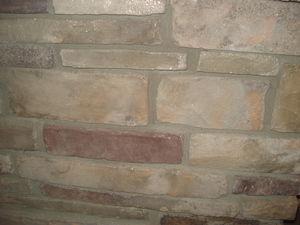Dress your windows with extravagant swags and tails. They look elaborate, but are really only a drape of fabric across the top of the window framed by separate pleated panels.
Classic swags and tails are one of the most lavish and popular curtain treatments. At first glance they look complicated, as though they are arranged from one long length of fabric. In fact this is only an illusion. They are actually made in three separate, manageable sections, which are simply stapled or held in place with Velcro, on a narrow pelmet shelf fixed above the window.
Traditionally, swags and tails give a formal look to a room, especially when they are teamed with full-length curtains. They can also be used on their own to frame a small window, or in conjunction with a blind or sheer curtain for a smart but less formal effect.
You can use the same fabric for the curtains and swags and tails, or opt for a complete contrast in color or pattern. The lining will also be on show when the tails are pleated up. A contrast lining will accentuate the pleats, while repeating the main fabric as a lining gives a more understated effect.
Designing swags and tails:
These instructions show how to make a pattern for swags and tails by draping fabric, so that you can check the style suits your window, before cutting out the main fabric. For different effects, you can vary the number of swags, the way the tails are pleated and the arrangement of the swags and tails together, such as positioning the swags under or over the tails. As a guide, a single swag should be about one-fifth the depth of the curtain and no wider than 40 inches (102cm); if your window is very wide, then it is better to make two or three smaller swags. Each tail is generally one third as long as the curtain or window length, with the shortest point slightly lower than the center of the swag.
Alternately, you can buy commercial paper patterns, which you will find at the back of dressmaking pattern books.
Putting up a pelmet shelf:
Before you can hang the swags and tails, or even start making the fabric pattern, you will have to fix a narrow pelmet shelf above the window. To do this you will need:
- ½ inch (12mm) ply wood
- Electric drill
- Wall plugs
- 1 ½ inch (38mm) angle brackets
- Woodscrews and screwdriver
1. Cut a length of 4 inch (10cm) wide plywood so that it extends 2-3 inches (5-7.5cm) beyond the curtain track at each end. Or have it cut to size at the DIY store or timber merchants.
2. To fix the shelf, mark the position of the shelf centrally 2-3 inches (5-7.5cm) above the curtain track. With a masonry bit, drill holes in the wall for fixing the angle brackets at each end of the shelf and at 12 inch (30cm) intervals in-between. Fit wall plugs and attach brackets with 1 ¼ inch (32mm) woodscrews. Rest the shelf on top and fix in place with 3/8 inch (10mm) woodscrews, screwing upwards. Mark the center of the shelf.
Making patterns:
Use an old sheet, or soft fabric like muslin, to make the test patterns. The tails are shaped on the pelmet shelf, and the test swag is checked up there too, so you need a ladder, lots of pins and sticky tape to hold the fabric while you judge the effect.
These instructions who how to make a single swag with five folds, teamed with tripe pleated tails that sit on top of the swag. However, it is easy to adapt the instructions to change the number of folds in the swag and pleat in the tails.
You will need:
- Two tape measures (or one plus some cord)
- Pencil and paper
- Ladder
- Muslin or old sheet
- Felt tip pen
- Sticky tape or tacks
1. To measure up hang a tape measure, 4 inches (10cm) in from each end of the pelmet shelf, to the desired depth of the swag. Measure the width of the swag and the depth at the center. Measure down each side of the window to the desired inner length and outer length of the tails. Measure the width of the tails to cover the swag edges.
2. Marking up the swag. On the test fabric, draw a rectangle the width of the swag plus 16 inches (40cm), by 1 ½ times the depth of the swag, plus 2 inches (5cm) for overlapping on top of the shelf. Then mark 8 inches (20cm) in from each side on the top long edge. Draw a diagonal line from each mark to the corresponding corner on the lower edge. Divide and mark each diagonal evenly into one more space than the number of folds planned. For example, for five folds, mark six equal spaces.
3. Folding the swag. It is easiest to shape the swag when it is pinned on a low surface like an ironing board. Pick up and pin along the top edge, 5 inches (12.5cm) inside the line. Alternating from side to side, continue pinning marked folds, moving 1 inch (2.5cm) outwards to the corner each time.
4. Checking the draped effect. Adjust the folds until they hang symmetrically in soft sweeping drapes. When you are happy with the effect, trim away excess fabric from both ends and along the curved lower edge 3 inches (7.5cm) from the last fold. Then unpin it from the ironing board and tape it centrally on the pelmet shelf.
5. Drawing up a tail. Using the measurements taken at the window in Step 1, draw up on the test fabric a rectangle 3 times the finished width of the tail, plus the depth of the pelmet shelf (4 inches/10cm), by the longest length of the tail plus 3 inches (7.5cm) for fixing to the shelf. Down one side, mark the shortest length of the tail plus 3 inches (7.5cm). Draw a diagonal line from the shortest bottom measurement to the opposite longest bottom corner, and cut out the test pattern.
6. Pleating the tails. Using sticky tape or tacks, position the top 3 inches (7.5cm) of the tail on the shelf making sure to wrap it round the side as well. Pleat as you wish to the desired width, pinning folds in place on top of the shelf. Stand tack to check the effect and adjust if necessary. Take down the patterns.
Making the swag:
Unpin the folds in the fabric pattern piece, and then fold it in half length ways to check the pattern is even; adjust as necessary. For softer, more natural folds, cut out the swag on the bias. Use the pattern piece to work out how much fabric and lining you will need. Remember to add 5/8 inch (1.5cm) seam allowance to the pattern piece.
You will need:
- Furnishing fabric
- Contrasting fabric for lining
- Pins
- Matching sewing thread
- Sticky tape
- Sew ‘n’ stick Velcro
1. Cutting out fabric and lining. Cut out the swag so that the center is on the bias grain of the fabric. Find the bias by folding the cut edge to align with the selvage and marking this fold with pins. Fold the test swag in half length ways and press the fold line. Line up folds on the test swag and fabric, pin in position and cut out. Remember to transfer the pleat markings onto the fabric. It is easy to cut notches where the pleats will be.
2. Making up. With right sides together, pin, tack and stitch the lining to the main fabric along the curved bottom edge. Trim the seam allowance, turn right side out and press. The pin, tack and stitch the remaining three sides neatly together.
3. Folding. Pin the upper edge of the fabric to the top of an ironing board. Pleat up the ends of the swag at each notch, pinning the folds to check the effect.
4. Stitching the folds. When satisfied, unpin the swag from the ironing board. Tack, remove pins and then machine stitch across the folds to hold pleats in place.
5. Fixing up the swag. Cut a strip of Velcro to match the width of the swag. Stitch the hooked side along the top of the swag, 5/8 inch (1.5cm) from the edge. Fold the other side in half, align the center mark on the pelmet shelf and stick down, 1 ¾ inch (4.5cm) from the edge.
Making the tails:
Open the pattern piece out flat, with the position of the pelmet shelf return marked, to add a dart for a neat, boxed corner. (If the swags and tails fit into a window recess, no pelmet return is needed). Remember you are making two tails, so buy double the amount of fabric and lining needed for the test pattern.
1. Cutting out the tails. Cut out one tail in fabric and lining, adding 5/8 inch (1.5cm) seam allowance all round. Then flip the test tail over and cut out the second pieces of fabric and lining, as the mirror image of the first.
2. Making up the tails. For each tail, with right sides together and edges matching, stitch the lining fabric to the main fabric down both sides and along the slanted lower edge, leaving the top edge open. Trim seam allowances, clip across corners and turn right side out before pressing. Zigzag stitch upper edges together.
3. Shaping round pelmet shelf. Fold the long side of the tail back on itself, right sides together, along the marked corner line. Make a dart by stitching through all layers of fabric from the outer corner of the shelf to the top corner of the tail, so that it will fit neatly over the edge. Repeat on the other tail.
4. Pleating. Fold each tail into evenly spaced pleats to match the test tails, and pin and tack together across the top. Tape the tails in place on the shelf to check the fit. Take the tails down and machine across the top to hold the pleats in place. Press the folds along their length if you want a tailored effect.
5. Attaching Velcro. Stitch the hooked side of the Velcro to the underside of the tails along the back edge and corner, and attach the other half to the top of the shelf. Hang the tails in place, adding extra tabs of Velcro if necessary when the swags and tails overlap. Even quicker than Velcro, use a staple gun to attach the swags and tails to the pelmet shelf. Alternatively, use upholstery tacks, tapped in place with a hammer.



